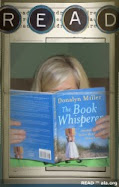 Mom: "Did you know that the word waffle can be used as a verb?"
Mom: "Did you know that the word waffle can be used as a verb?"Daughter: "No. How?"
Mom: "Well, when you waffle, you are slow to make a decision. You are a bit wishy-washy. If you waffle a lot, you can be called a waffler."
Daughter: "Oh. I waffle sometimes."
Mom: "The waffle doesn't fall far from the iron."
This discussion took place after we picked up Waffle by Chris Raschka. The adorable main character is a one whale of a waffler. On each page, he wonders, worries, wiggles, wabbles and waffles. He feels awful to be a waffler. But all of this "waffley" activity leads to a wonderful ending. Waffle ends up working a wonder within. You'll have to read the book to find out what that wonder is.
Writing Minilesson ideas:
Presentation: In the middle of the book, there are two pages on which the word waffle is repeated. (a lot!) You really have to see it to get the full idea, but the placement of the letters in the word waffle is very clever and worth pointing out to kids.
Sentence fluency/Word Choice/Subject-Verb Agreement: On several pages, there are only two words- the subject and the predicate. Challenge your students during Writer's Workshop to include some two-word sentences in their pieces. Discuss how this adds to the voice of the piece. Discuss the reasons an author might have to do this. Or you may want to give them some two word sentences and challenge them to stretch the sentences out by adding carefully chosen words.
Use of the dash: On several pages in a row, Raschka uses a dash. (Waffle wondered what if--/ Waffle wished that he would--/ Waffle wanted to, well--) Discuss with your students their thoughts on why the author may have used the dash in this way. In my opinion, he uses it to emphasize that he's such a waffler, he even has a hard time committing to all of the words in a complete sentence! Challenge your students to try out using dashes in their writing.
Alliteration: This book is a natural to teach alliteration. See if you can motivate your students to try some alliteration in their writing.
Reading Minilessons:
Questioning: Until the end of the book, the reader has no idea what poor Waffle is so worked up about. I think your curious kids will ask the question, "Why is he so worried?" after the first few pages.
Predicting: Generate a list of probable reasons that Waffle could be so worried.
Making Connections: Most kids have been this worried about something in their short little lives. They could do a quick write about a time when they were feeling this way. If you use this book at the beginning of the year, they can write about the things that cause them anxiety as they enter a new grade.
Synthesizing: This book speaks to the power of finding strength from within. If you haven't already, begin a "theme" chart and write the theme (or lesson) and the book title. Continue to look for the larger themes in read-alouds throughout the year.
This is a quirky, clever little book. Chris Raschka was able to write it in 55 words, with the exception of the aforementioned 2 page spread on which the same word was repeated across each page. That's craft.
Grab this book at LaGrange Memorial Library and let me know what you think of it. No waffling-- just do it!



